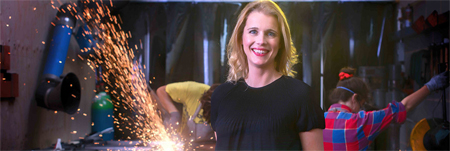I think at this time of year, those of us who are lucky enough to get a break for the holiday season are just hanging on in there until it’s time to officially put their feet up. We thought we’d help you prepare for all those parties and extra time with the kids with some rather cool Chemistry Party Tricks though!
With all the hype in the news about the chemicals in our food, people forget that quite a lot of them are naturally produced and are rather important! We found some great information on chemicals in your every day festive dinner that is great to play around with…
Try red cabbage: Full to the brim of chemicals called anthocyanins (most red or purple fruit and veg, and poinsettias, contain them). The anthocyanins leach out of the cabbage when you cook it, turning the water purple. Before you throw the cabbage water away pour some into two or three glasses. Then add a few drops of vinegar to one glass, bicarbonate of soda to the second and washing soda to the third. Watch it change so that each glass now contains a different coloured liquid! It’s all down to a property of anthocyanins that causes them to change colour in response to acids and alkalis.
Check out the candles: A great party trick for the dinner table. Candles are made from a mixture of chemicals called alkanes, which together form paraffin wax. When you light them you trigger an exothermic (heat-producing) chemical reaction between the wax and the oxygen in the air resulting in carbon dioxide and water.
Blow out the candle and of course you’ll see the smoke rising from the extinguished wick. But what you can’t see is the paraffin vapour also rising from the hot pool of wax. That vapour is flammable, so try holding a match in the smoke an inch or so above the wick. Hey presto, the flame jumps down the vapour trail and the candle reignites!
Don’t put the candle away just yet, but do get yourself a thick-skinned orange and think of the tasty zest that turns up in so many holiday recipes. Part of the peel’s appeal comes from a chemical called limonene. It’s this that generates that lovely smell you get when peeling the orange and it’s the oily substance you see squirting out from the zest. It also happens to be highly flammable. So while you’re munching on the fruit or making mincemeat try squeezing a bit of the limonene out of the orange peel and towards a candle flame (make sure there are no dangling decorations in the way). Get it right and you’ll be treated to an impressive jet of flame. PLEASE TAKE CARE AND BE SENSIBLE IF YOU TRY THIS!!
When you’re so full that you’re wishing you borrowed your great uncle’s spare trousers with the elasticated waist, the plum pudding is served. It looks so appetising, bathed in a blue glow as the brandy burns merrily away, but have you ever wondered why the pudding doesn’t end up as a cinder from all that burning alcohol? Well, the brandy is about 60% water. So when you set it alight the energy from the burning alcohol gets absorbed by the water. The water then evaporates, which keeps the temperature of the pudding low (in the same way that sweat evaporating keeps you cool) and so stops the pudding getting scorched. And since the alcohol burns off well before all the water has evaporated, you are left with a slightly damp pudding.
There’s a little insight and some cool tricks for the chemicals laid out before you on December 25th. Before you tuck in, don’t forget to raise your silicon dioxide vessel, filled with your favourite mixture of ethanol, dihydrogen monoxide and assorted flavourings, and toast chemistry this holiday. If you want something great to watch at the same time then don’t forget the RI Christmas Lectures!
(Information from historic article by Mark Lorch)





